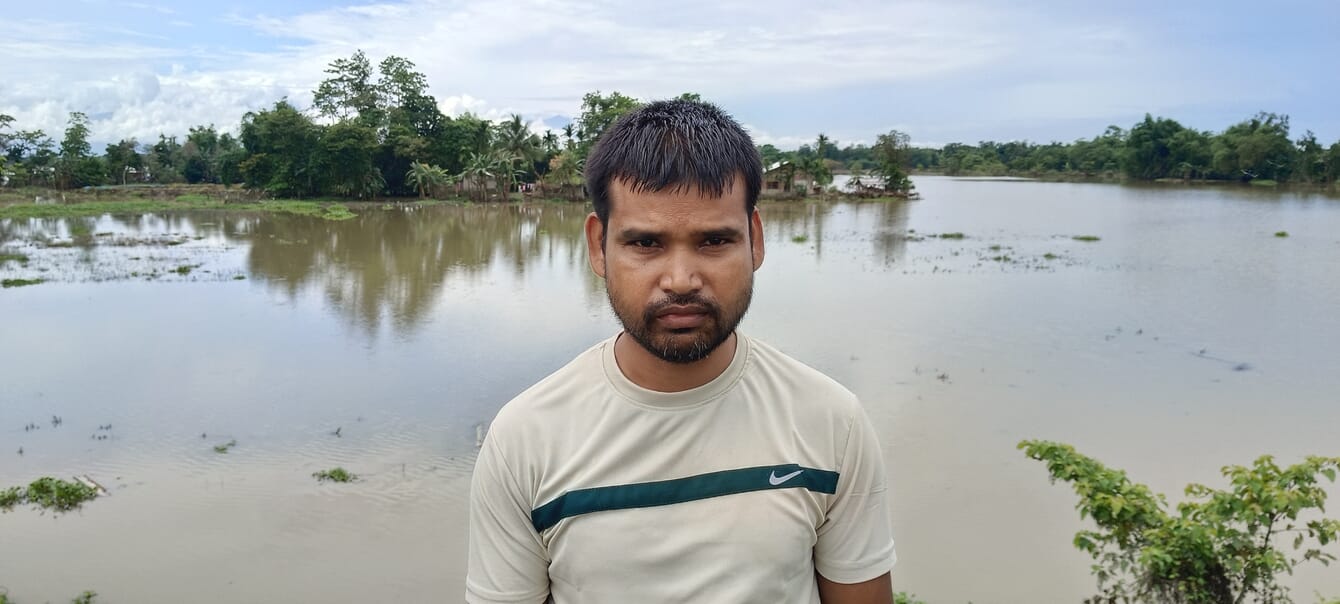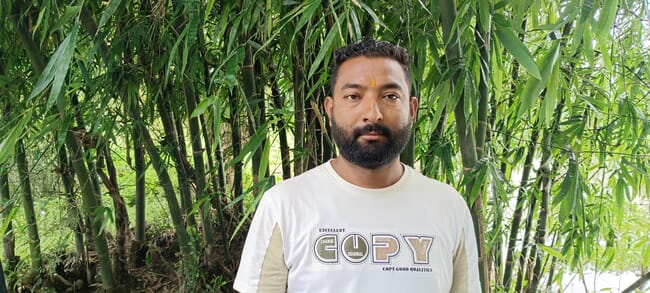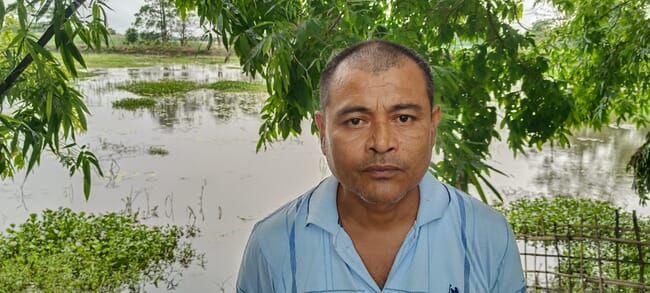
© Gurvinder Singh
Kamal Das was planning to buy a new four-wheeler for his family from the income he had expected to generate from his carp farm this year.
But the hopes of the 42-year-old farmer, who hails from Aamtola Pakadol village in the North Lakhimpur (NLP) district of Assam, were washed away in the severe floods that lashed the state in the last week of May.
He suffered severe losses, as his entire stock was washed away in the flood water.
“I had around 30 quintals [3 tonnes] of carp in my pond, with each weighing up to 5 kg. But the entire stock spread across 0.25 hectares of water body has been lost in the floods. The water rose up to 10 feet, submerging our fields and houses. We rushed to our safety, leaving everything. I had taken a loan for the business, but the floods have ruined me.”
Das is not alone, as hundreds of fish farmers in the district have suffered severe losses.
“It was raining heavily since the morning of 29 May without stopping even for a moment. The water level started rising and flooding our ponds. Slowly the water devoured everything. We were expecting the situation to turn normal once the rains stopped but it didn’t happen and destroyed our fish ponds,” recalls Mohan Parajuli, a fish farmer in 9/6 Koilamari village.
“The flood situation got aggravated by the excessive water released by the authorities of North Eastern Electric Power Corporation (NEEPCO), a dam project in the neighbouring state of Arunachal Pradesh that breached our embankments and the stock vanished in a few seconds,” he added.
Mohan Parajuli, 33, had returned home after working outside the state for several years and ventured into fish farming along with his father, last year. He was expecting good returns, but the floods made him penniless.
“I invested around Rs 2 lakhs ($2,332) and had just stocked the seeds of Indian major carp in the pond, expecting to make good profit. I had made an income of Rs 45,000 ($524) last year, which encouraged me to increase my investment. But everything has been washed away in the floods and the losses have devoured my savings and investment.”

© Gurvinder Singh
Farmers in the region said that their ponds are located close to Ranganadi River, a tributary of the Brahmaputra, where floods occur every year, but don’t usually cause this kind of damage.
“We live in a state where floods are an annual occurrence, but [normally] cause minimal damage to fish farming in our portion of the state. But the situation has been completely different this time, as the floods have destroyed our entire farming. I had never witnessed such ferocious floods in the past 15 years. I have also lost all the carp that were stocked for the past 2-3 years,” said Harimohan Chhetri, 56.
What is notable is that the devastation happened before the monsoon arrived in northeast India.
Debeswar Sonowal, assistant fisheries officer in NLP estimated that around 2,500 fish farmers in the region have suffered losses in the floods.
“The stocking time starts around May and continues till June. Famers usually take loans to start a new crop every year. But the floods coincided with the sowing period and have also washed away their old stocks. I have already sent a ground report to the government and am waiting for the compensation to arrive. We are yet to estimate the total monetary losses of the farmers.”
Farmers affected by losses from natural disasters are paid Rs 10,000 ($117) per hectare, but they say this is insufficient.
“The government should raise the compensation to a minimum amount of Rs 50,000 ($583) per hectare, as we invest over 1 lakh ($1,165) in farming. The rising inflation and cost of raw material has already affected our profits,” added Harimohan.

© Gurvinder Singh
The impact of climate change
Fish farming in Assam is a traditional activity, with earthen, rain-fed ponds, mainly stocked with Indian major carp.
Scientists say that the state’s climate change trends reveal decreasing rainfall in the summer, monsoon and post-monsoon season, and an increase of in rainfall during the winters.
“Erratic rainfall has been leading to untimely devastating floods and drought-like conditions in some places of the state, impacting the management of fish farms as well as breeding and production of fish,” said Dr Bibha Chetia Borah, a former principal scientist at Assam Agricultural University.
“The farmers should take up pre-flood measures that include creating high and strong pond embankments, turfing the embankment with grass and other suitable plant species, encircling the ponds with fine net along the embankment and proper drainage systems in their farm complex. Proper steps should also be taken to prevent the fish from escaping with overflow of water by using floating cages,” she said.
Farmers can also shift to climate-smart technologies like integrated farming systems involving fish and terrestrial crops, short-term carp culture during the flood-free period, RAS, biofloc and location-specific improvisations to achieve sustainable production under adverse climatic conditions, she added.




